Photo
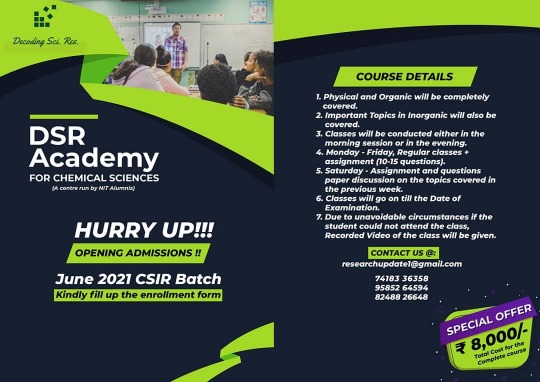
Greetings from DSR Academy For Chemical Sciences (A centre run by NIT alumnis) We are opening admissions for June 2021 CSIR batch. Online classes will commence from the 1st of March 2021 and continue till the date of examination. Course details and fees are given in the poster For any queries regarding the course Call us at 7418336358 / 9585264594 / 8248826648 Email us: [email protected] (at National Institute of Technology Tiruchirappalli) https://www.instagram.com/p/CLpERhqjgfL/?igshid=dwf8q4rryohu
0 notes
Photo

"For me, justice is the first condition of humanity." - Literature laureate, playwright and poet Wole Soyinka. Soyinka is a firm believer in justice for all and dedicated his Nobel Lecture to speaking about the eradication of human inequality and the end of racism. The 1986 Nobel Prize in Literature was awarded to Wole Soyinka "who in a wide cultural perspective and with poetic overtones fashions the drama of existence." Photo: Alexander Mahmoud. #NobelPrize #NobelLaureate #literature Posted @nobelprize_org (at National Institute of Technology Tiruchirappalli) https://www.instagram.com/p/CKzH8qIjVmu/?igshid=hh382l5gxwge
0 notes
Video
Highly branched vascular networks are widespread in biology, as efficient ways of transporting oxygen and nutrients to cells. To make vascular networks in the lab, the blueprints for the complex branching features must be designed, as well as a method to physically produce them. The video shows a Mutual Tree Attraction algorithm, which uses a “grow” pattern based on leaf venation to create a dendritic network. The network has a single inlet and a single outlet, with trees that grow towards one another and connect in the central domain. Researchers at Rice University @riceuniversity used this algorithm to create dendritic networks using 3D printed sugar glass and found that this network could successfully support hepatocyte growth outside the body, research published in Nature Biomedical Engineering. The authors explain more about their research on the Nature Research Bioengineering Community https://go.nature.com/33WC9cw (link in bio). #liver #bioengineering #tissue #network #vascular #algorithm Posted @withregram • @nature.research (at National Institute of Technology Tiruchirappalli) https://www.instagram.com/p/CKwSyr4jsdJ/?igshid=1068psfauoe8m
0 notes
Photo

The wonder of chemistry Credits: @veejey65 Follow💗 @decoding_scientific_research 💛 for more knowledge💓, mems💜, fun💙 and information💘 about science and research.💚 @decoding_scientific_research @decoding_scientific_research @decoding_scientific_research @decoding_scientific_research #research #researchers #researchanddevelopment #womeninscience #liftedlife #phdstudentlife #phdchat #phdstudentsofinstagram #sciencecommunication #urbanresearch #science #phd #chemistry #scientist #harvard #sciences #scienceart #knowledge #physics #scientist #chemistry #science #nobleprize2020 #noblepeaceprize #nobleprize #nobleprizewinner #nobleprizewinners #nobleprizeinliterature #atom #alberteinstein #sciencememe (at National Institute of Technology Tiruchirappalli) https://www.instagram.com/p/CKjVnyRjgX6/?igshid=gzr962pn6r1
#research#researchers#researchanddevelopment#womeninscience#liftedlife#phdstudentlife#phdchat#phdstudentsofinstagram#sciencecommunication#urbanresearch#science#phd#chemistry#scientist#harvard#sciences#scienceart#knowledge#physics#nobleprize2020#noblepeaceprize#nobleprize#nobleprizewinner#nobleprizewinners#nobleprizeinliterature#atom#alberteinstein#sciencememe
0 notes
Video
Kindly look the bio to find the link. (at National Institute of Technology Tiruchirappalli) https://www.instagram.com/p/CKVOtV9jMhG/?igshid=1spjeg0kz31o6
0 notes
Video
Happy learning. https://drive.google.com/folderview?id=1oqlqKM0VhLSb_wfAuB4FhXY5UEj8o7cS Follow💗 @decoding_scientific_research 💛 for more knowledge💓, mems💜, fun💙 and information💘 about science and research.💚 @decoding_scientific_research @decoding_scientific_research @decoding_scientific_research @decoding_scientific_research #research #researchers #researchanddevelopment #womeninscience #liftedlife #phdstudentlife #phdchat #phdstudentsofinstagram #sciencecommunication #urbanresearch #science #phd #chemistry #scientist #harvard #sciences #scienceart #knowledge #physics #scientist #chemistry #science #nobleprize2020 #noblepeaceprize #nobleprize #nobleprizewinner #nobleprizewinners #nobleprizeinliterature #atom (at National Institute of Technology Tiruchirappalli) https://www.instagram.com/p/CKVOLEDj2TZ/?igshid=w077in2yqsie
#research#researchers#researchanddevelopment#womeninscience#liftedlife#phdstudentlife#phdchat#phdstudentsofinstagram#sciencecommunication#urbanresearch#science#phd#chemistry#scientist#harvard#sciences#scienceart#knowledge#physics#nobleprize2020#noblepeaceprize#nobleprize#nobleprizewinner#nobleprizewinners#nobleprizeinliterature#atom
0 notes
Photo
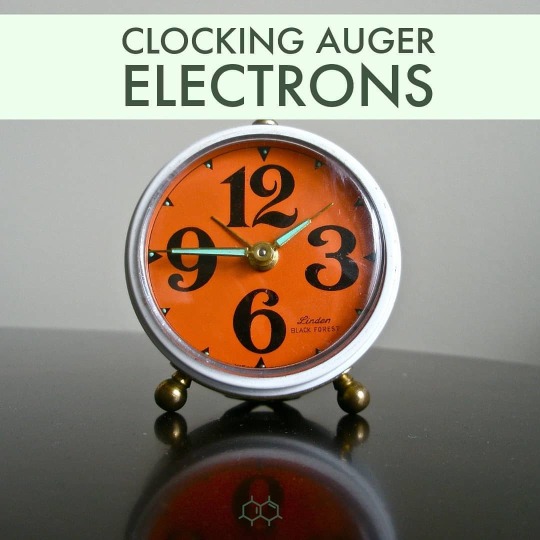
Intense X-ray free-electron lasers (XFELs) can rapidly excite matter, leaving it in inherently unstable states that decay on femtosecond timescales. The relaxation occurs primarily via Auger emission, so excited-state observations are constrained by Auger decay. In situ measurement of this process is therefore crucial, yet it has thus far remained elusive in XFELs owing to inherent timing and phase jitter, which can be orders of magnitude larger than the timescale of Auger decay. Here we develop an approach termed ‘self-referenced attosecond streaking’ that provides subfemtosecond resolution in spite of jitter, enabling time-domain measurement of the delay between photoemission and Auger emission in atomic neon excited by intense, femtosecond pulses from an XFEL. Using a fully quantum-mechanical description that treats the ionization, core-hole formation and Auger emission as a single process, the observed delay yields an Auger decay lifetime of 2.2+0.2−0.32.2−0.3+0.2 fs for the KLL decay channel. Source: Nature Physics Follow💗 @decoding_scientific_research 💛 for more knowledge💓, mems💜, fun💙 and information💘 about science and research.💚 @decoding_scientific_research @decoding_scientific_research @decoding_scientific_research @decoding_scientific_research #research #researchers #researchanddevelopment #womeninscience #liftedlife #phdstudentlife #phdchat #phdstudentsofinstagram #sciencecommunication #urbanresearch #science #phd #chemistry #scientist #harvard #sciences #scienceart #knowledge #physics #scientist #chemistry #science #nobleprize2020 #noblepeaceprize #nobleprize #nobleprizewinner #nobleprizewinners #nobleprizeinliterature #atom #alberteinstein #sciencememes #quantumphysics #quantummechanics (at National Institute of Technology Tiruchirappalli) https://www.instagram.com/p/CKSn9bqDTNO/?igshid=1l818bp6rgz0x
#research#researchers#researchanddevelopment#womeninscience#liftedlife#phdstudentlife#phdchat#phdstudentsofinstagram#sciencecommunication#urbanresearch#science#phd#chemistry#scientist#harvard#sciences#scienceart#knowledge#physics#nobleprize2020#noblepeaceprize#nobleprize#nobleprizewinner#nobleprizewinners#nobleprizeinliterature#atom#alberteinstein#sciencememes#quantumphysics#quantummechanics
0 notes
Photo

“Lattice surgery” has been used to quantum-mechanically entangle fault-tolerant topological qubits – an achievement that could lead to the production of more reliable quantum logic gates. Created by researchers in Austria, Switzerland and Germany, the entanglement technique could prove useful in the development of quantum error correction algorithms and ultimately to achieve scalable, large-scale quantum computation. In principle, quantum computers can quickly solve certain problems that would take an eternity to compute on even the most powerful conventional computer. While this “quantum advantage” has been established experimentally using small-scale quantum computers to solve highly-specialized problems, it remains a significant challenge to scale-up these devices to create larger, practical quantum computers that can solve a range of different problems. A big problem with today’s quantum devices is that errors are quickly introduced to a calculation via interactions with noise, heat and other disturbances from the surrounding environment. In classical computers, errors can be measured and corrected, but in quantum computers the very act of measuring a quantum bit (qubit) of information causes it to collapse. This build-up of errors puts severe limits on the size of a quantum computer and the size of the computation it can achieve. Indeed, the largest quantum computer to date – Google AI’s Sycamore – contains just 53 qubits, whereas a standard PC contains billions of conventional bits. Source: scienceworld.com (at National Institute of Technology Tiruchirappalli) https://www.instagram.com/p/CKDu27ZDQLb/?igshid=1l23dsc1jxk4j
0 notes
Photo

Scientists discover new state of matter: Liquid Glass A team of scientists from Germany and the Netherlands have used a technology called confocal microscopy to discover a new state of matter, Liquid Glass, hidden inside mysterious transformations that happen between liquid and solid states of glass. "Suspensions of colloidal particles are widely spread in nature and technology and have been studied intensely over more than a century," said co-senior author Professor Andreas Zumbusch, Department of Chemistry, University of Konstanz. "When the density of such suspensions is increased to high volume fractions, often their structural dynamics are arrested in a disordered, glassy state before they can form an ordered structure." Follow💗 @decoding_scientific_research 💛 for more knowledge💓, mems💜, fun💙 and information💘 about science and research.💚 @decoding_scientific_research @decoding_scientific_research @decoding_scientific_research @decoding_scientific_research #knowledge #physics #scientist #chemistry #science #nobleprize2020 #noblepeaceprize #nobleprize #nobleprizewinner #nobleprizewinners #nobleprizeinliterature #atom #alberteinstein #sciencememes #quantumphysics #quantummechanics #knowledgeispower #nobleprize2019 #ramaneffect #cvraman (at National Institute of Technology Tiruchirappalli) https://www.instagram.com/p/CKDY8tFDNHm/?igshid=1u7oukdkjxzof
#knowledge#physics#scientist#chemistry#science#nobleprize2020#noblepeaceprize#nobleprize#nobleprizewinner#nobleprizewinners#nobleprizeinliterature#atom#alberteinstein#sciencememes#quantumphysics#quantummechanics#knowledgeispower#nobleprize2019#ramaneffect#cvraman
0 notes
Photo

Survey highlighting the subjective nature of colour prompts scientists to create new tools to improve chemical records . Records for around 9000 of the over 100,000 MOFs listed in the Cambridge Structure Database (CSD) include a colour. A Twitter survey by Berend Smit and colleagues at the Swiss Federal Institute of Technology Lausanne (EPFL) saw participants assign 4184 different colours to the 162 colour names used to describe MOFs in the CSD. The survey highlighted just how subjective colour descriptions are. Now, Smit’s team has developed two web applications to help users maintain objectivity when using colours to describe their MOFs. . The first app, called Color Calibrator, assigns tristimulus values to MOFs. Tristimulus values are a mathematical way to represent colour. Where one person identifies a colour as cherry red and another calls it poppy red; these values will represent the same colour. Users upload an image of their MOF alongside a colour calibration card and the app can be set to automatically upload the colour information in a standardised format to an electronic lab notebook. . The second app, called MOF colorizer, predicts the colour of a MOF based on its structure. Smit’s team encoded a variety of structural information to allow for colour predictions based on all possible features. A machine-learning model then analyses the structures to generate a colour name, based on the most likely colour descriptor according to data from the Twitter survey. Source: Chemistry World Follow💗 @decoding_scientific_research 💛 for more knowledge💓, mems💜, fun💙 and information💘 about science and research.💚 @decoding_scientific_research @decoding_scientific_research @decoding_scientific_research @decoding_scientific_research #research #researchers #researchanddevelopment #womeninscience #liftedlife #phdstudentlife #phdchat #phdstudentsofinstagram #sciencecommunication #urbanresearch #science #phd #chemistry #scientist #harvard #sciences #scienceart #knowledge #physics #scientist #chemistry #science #nobleprize2020 #noblepeaceprize #nobleprize #nobleprizewinner (at National Institute of Technology Tiruchirappalli) https://www.instagram.com/p/CJ8_jKHjCPO/?igshid=cevp33c5ku5x
#research#researchers#researchanddevelopment#womeninscience#liftedlife#phdstudentlife#phdchat#phdstudentsofinstagram#sciencecommunication#urbanresearch#science#phd#chemistry#scientist#harvard#sciences#scienceart#knowledge#physics#nobleprize2020#noblepeaceprize#nobleprize#nobleprizewinner
0 notes
Photo

The heterocyclic beryllole is the first antiaromatic molecule containing an alkaline earth metal in its π system.1 While metals of the p, d and f block of the periodic table have all been shown to engage in π systems, there has never before been any aromatic or antiaromatic compounds containing s-block elements. Alkaline earth metals had been considered simply too inflexible in terms of their oxidation states to allow them to participate in π bonding. However, a few promising candidates for the first s-block π system emerged within the last decade. Source: Chemistry World Follow💗 @decoding_scientific_research 💛 for more knowledge💓, mems💜, fun💙 and information💘 about science and research.💚 @decoding_scientific_research @decoding_scientific_research @decoding_scientific_research @decoding_scientific_research #research #researchers #researchanddevelopment #womeninscience #liftedlife #phdstudentlife #phdchat #phdstudentsofinstagram #sciencecommunication #urbanresearch #science #phd #chemistry #scientist #harvard #sciences #scienceart #knowledge #physics #scientist #chemistry #science #nobleprize2020 #noblepeaceprize #nobleprize #nobleprizewinner #nobleprizewinners #quantumphysics #quantummechanics #ramaneffect (at National Institute of Technology Tiruchirappalli) https://www.instagram.com/p/CJxA8oWj00B/?igshid=wjb6xbpjdl1h
#research#researchers#researchanddevelopment#womeninscience#liftedlife#phdstudentlife#phdchat#phdstudentsofinstagram#sciencecommunication#urbanresearch#science#phd#chemistry#scientist#harvard#sciences#scienceart#knowledge#physics#nobleprize2020#noblepeaceprize#nobleprize#nobleprizewinner#nobleprizewinners#quantumphysics#quantummechanics#ramaneffect
0 notes
Photo
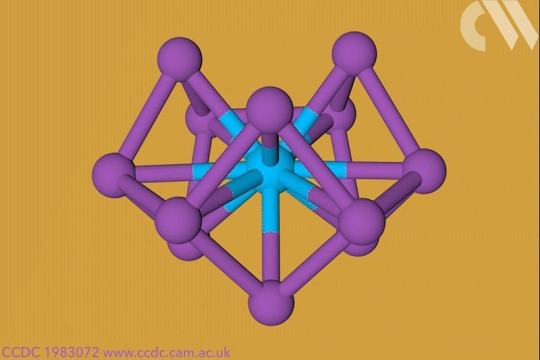
Heavy-metal cluster sets size record for metal aromaticity The aromatic cluster consists of 12 bismuth atoms (purple) around a central thorium atom (blue) A 12-membered bismuth ring has become the biggest Hückel aromatic molecule made purely from metal atoms. Despite having only two π electrons, the compound’s ring current – an indicator of aromaticity – is similar to that of porphine with its 26 π-electrons. Since the discovery of aromaticity in the 19th century, it has been a property mostly reserved for carbon compounds with the occasional heteroatom. In 2001, chemists reported the first all-metal aromatic compound, a four-aluminium ring. Over the years, more examples of π-aromatic clusters have emerged, though none of them containing more than five metal atoms. ‘Our compound is a new milestone, as the system is much larger,’ says Stefanie Dehnen from the University of Marburg in Germany. Together with her colleague Florian Weigend, she led a team that has made an anionic 12-bismuth ring stabilised by a central thorium cation. It is the biggest all-metal molecule that is aromatic according to Hückel’s 4n+2 rule. Source : chemistry world Tags Follow💗 @decoding_scientific_research 💛 for more knowledge💓, mems💜, fun💙 and information💘 about science and research.💚 @decoding_scientific_research @decoding_scientific_research @decoding_scientific_research @decoding_scientific_research #research #researchers #researchanddevelopment #womeninscience #liftedlife #phdstudentlife #phdchat #phdstudentsofinstagram #sciencecommunication #urbanresearch #science #phd #chemistry #scientist #harvard #sciences #scienceart #knowledge #physics #scientist #chemistry #science #atom #alberteinstein #sciencememes #quantumphysics #quantummechanics #knowledgeispower (at National Institute of Technology Tiruchirappalli) https://www.instagram.com/p/CJsaZ3Pjst8/?igshid=1id1dzf8y7hoe
#research#researchers#researchanddevelopment#womeninscience#liftedlife#phdstudentlife#phdchat#phdstudentsofinstagram#sciencecommunication#urbanresearch#science#phd#chemistry#scientist#harvard#sciences#scienceart#knowledge#physics#atom#alberteinstein#sciencememes#quantumphysics#quantummechanics#knowledgeispower
0 notes
Video
Have a great year ahead. Keep working smart. (at National Institute of Technology Tiruchirappalli) https://www.instagram.com/p/CJq3LQHjeTh/?igshid=5psy5xkhhwzg
0 notes
Photo

A team working with Roland Fischer, Professor of Inorganic and Metal-Organic Chemistry at the Technical University Munich (TUM) has developed a highly efficient supercapacitor. The basis of the energy storage device is a novel, powerful and also sustainable graphene hybrid material that has comparable performance data to currently utilized batteries. Usually, energy storage is associated with batteries and accumulators that provide energy for electronic devices. However, in laptops, cameras, cellphones or vehicles, so-called supercapacitors are increasingly installed these days. Unlike batteries they can quickly store large amounts of energy and put it out just as fast. If, for instance, a train brakes when entering the station, supercapacitors are storing the energy and provide it again when the train needs a lot of energy very quickly while starting up. However, one problem with supercapacitors to date was their lack of energy density. While lithium accumulators reach an energy density of up to 265 Kilowatt hours (KW/h), supercapacitors thus far have only been delivering a tenth thereof. Sustainable material provides high performance, team working with TUM chemist Roland Fischer has now developed a novel, powerful as well as sustainable graphene hybrid material for supercapacitors. It serves as the positive electrode in the energy storage device. The researchers are combining it with a proven negative electrode based on titan and carbon. The new energy storage device does not only attain an energy density of up to 73 Wh/kg, which is roughly equivalent to the energy density of a nickel metal hydride battery, but also performs much better than most other supercapacitors at a power density of 16 kW/kg. The secret of the new supercapacitor is the combination is out. (at National Institute of Technology Tiruchirappalli) https://www.instagram.com/p/CJq3HBTjHMW/?igshid=fy3547gsja9h
0 notes
Photo
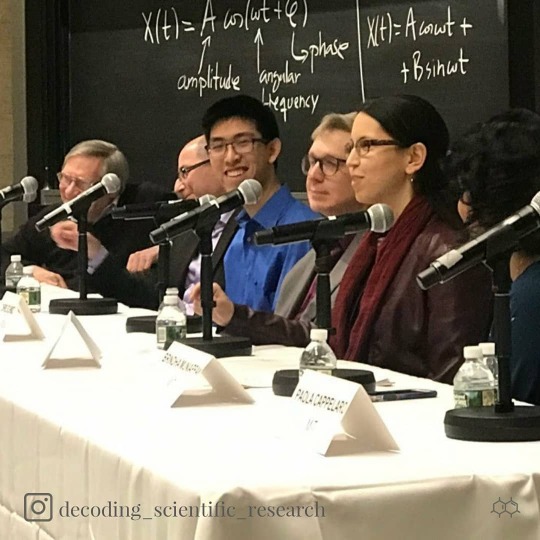
One fine evening, audience members packed into a lecture hall in MIT’s physics building. Undergraduates, members of the public, faculty members, and other scholars came to watch a film premiere and a panel discussion. NOVA had produced the film, “Einstein’s Quantum Riddle,” which stars entanglement. Entanglement is a relationship between quantum systems such as electrons. Measuring two entangled electrons yields two outcomes, analogous to the numbers that face upward after you roll two dice. The quantum measurements’ outcomes can exhibit correlations stronger than any measurements of any classical, or nonquantum, systems can. Which die faces point upward can share only so much correlation, even if the dice hit each other. Dice feature in the film’s explanations of entanglement. So does a variation on the shell game, in which one hides a ball under one of three cups, shuffles the cups, and challenges viewers to guess which cup is hiding the ball. The film derives its drama from the Cosmic Bell test. Bell tests are experiments crafted to show that classical physics can’t describe entanglement. Scientists recently enhanced Bell tests using light from quasars—ancient, bright, faraway galaxies. Mix astrophysics with quantum physics, and an edgy, pulsing soundtrack follows. I’ve swum in oceans and lakes, studied how the moon generates tides, and canoed. But piloting a steamboat along the Mississippi would baffle me. I could learn, given time, instruction, and practice; so can you learn quantum theory. Don’t let “weirdness,” “bizarreness,” or “counterintuitiveness” intimidate you. Humans can intuit quantum physics. Follow💗 @decoding_scientific_research 💛 for more knowledge💓, mems💜, fun💙 and information💘 about science and research.💚 @decoding_scientific_research @decoding_scientific_research @decoding_scientific_research @decoding_scientific_research #research #researchers #researchanddevelopment #womeninscience #liftedlife #phdstudentlife #phdchat #phdstudentsofinstagram #sciencecommunication #urbanresearch #science #phd #chemistry #scientist #harvard #sciences #scienceart (at National Institute of Technology Tiruchirappalli) https://www.instagram.com/p/CJciDN6D31q/?igshid=ik5o88tdmtac
#research#researchers#researchanddevelopment#womeninscience#liftedlife#phdstudentlife#phdchat#phdstudentsofinstagram#sciencecommunication#urbanresearch#science#phd#chemistry#scientist#harvard#sciences#scienceart
0 notes
Photo
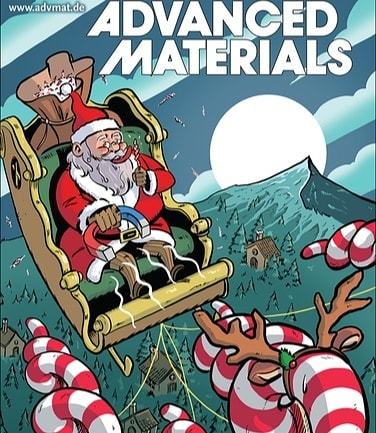
Sugars are ubiquitous in food, and are among the main sources of energy for almost all forms of life. Sugars can also form structural building blocks such as cellulose in plants. Because of their inherent degradability and biocompatibility characteristics, sugars are compelling materials for transient devices. Here, an additive manufacturing approach for the production of magnetic sugar‐based composites is introduced. First, it is shown that sugar‐based 3D architectures can be 3D printed by selective laser sintering. This method enables not only the caramelization chemistry but also the mechanical properties of the sugar architectures to be adjusted by varying the laser energy. It is also demonstrated that mixtures of sugar and magnetic particles can be processed as 3D composites. As a proof of concept, a sugar‐based millimeter‐scale helical swimmer, which is capable of corkscrew motion in a solution with a viscosity comparable to those of biological fluids, is fabricated. The millirobot quickly dissolves in water, while being manipulated through magnetic fields. The present fabrication method can pave the way to a new generation of transient sugar‐based small‐scale robots for minimally invasive procedures. Due to their rapid dissolution, sugars can be used as an intermediate step for transporting swarms of particles to specific target locations. Source: Advanced Materials, Wiley Publication Follow💗 @decoding_scientific_research 💛 for more knowledge💓, mems💜, fun💙 and information💘 about science and research.💚 @decoding_scientific_research @decoding_scientific_research @decoding_scientific_research @decoding_scientific_research #research #researchers #researchanddevelopment #womeninscience #liftedlife #phdstudentlife #phdchat #phdstudentsofinstagram #sciencecommunication #urbanresearch #science #phd #chemistry #scientist #harvard #sciences #scienceart (at National Institute of Technology Tiruchirappalli) https://www.instagram.com/p/CJcgB1Kjimk/?igshid=5wfhnic70lns
#research#researchers#researchanddevelopment#womeninscience#liftedlife#phdstudentlife#phdchat#phdstudentsofinstagram#sciencecommunication#urbanresearch#science#phd#chemistry#scientist#harvard#sciences#scienceart
0 notes
Video
Failure-Experiment-Supported Optimization of Poorly-Reproducible Synthetic Conditions for Novel Lanthanide Metal-Organic Frameworks A series of novel metal organic frameworks with lanthanide double-layer-based inorganic subnetworks (KGF-3) was synthesized assisted by machine learning. Pure KGF-3 was difficult to isolate in the initial screening experiments. The synthetic conditions were successfully optimized by extracting the dominant factors for KGF-3 synthesis using two machine-learning techniques. Cluster analysis was used to classify the obtained PXRD patterns of the products and to decide automatically whether the experiments were successful or had failed. Decision tree analysis was used to visualize the experimental results, with the factors that mainly affected the synthetic reproducibility being extracted. The water adsorption isotherm revealed that KGF-3 possesses unique hydrophilic pores, and impedance measurements demonstrated good proton conductivities (σ = 5.2 × 10−4 S cm−1 for KGF-3(Y)) at a high temperature (363 K) and high relative humidity (95%). Tags Follow💗 @decoding_scientific_research 💛 for more knowledge💓, mems💜, fun💙 and information💘 about science and research.💚 @decoding_scientific_research @decoding_scientific_research @decoding_scientific_research @decoding_scientific_research #research #researchers #researchanddevelopment #womeninscience #liftedlife #phdstudentlife #phdchat #phdstudentsofinstagram #sciencecommunication #urbanresearch #science #phd #chemistry #scientist #harvard #sciences #scienceart (at National Institute of Technology Tiruchirappalli) https://www.instagram.com/p/CJaptFWDGAO/?igshid=1w3sqry4doisu
#research#researchers#researchanddevelopment#womeninscience#liftedlife#phdstudentlife#phdchat#phdstudentsofinstagram#sciencecommunication#urbanresearch#science#phd#chemistry#scientist#harvard#sciences#scienceart
0 notes